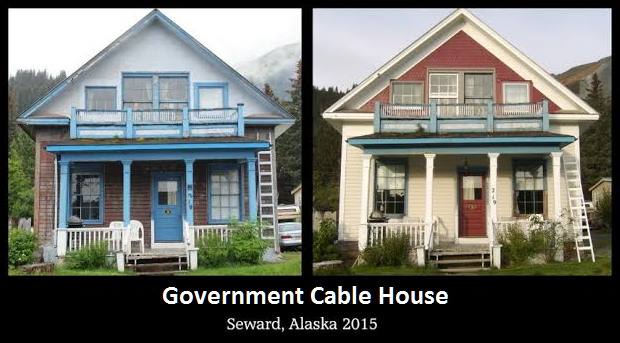City of Seward
Home Rule City
2022 Population: 2,482
Size: 21.5 Square Miles
Seward Historic Preservation Commission: The commission surveys and inventories community historic resources; reviews proposed nominations to the National Register of Historic Places; provides advice and information regarding the identification and protection of local historic and archaeological resources; supports the enforcement of state and local historic preservation laws; reviews and makes recommendations about local projects; develops a local historic plan; and periodically reports to the city council. Seven members are appointed by the City of Seward Council to three year terms and consist of residents of the City of Seward or surrounding areas. To the extent available in the community, the commission should include an architect or historical architect, an archaeologist, and a historian.
Date certified: May 18, 1992
Meets: Two meetings a year, at minimum, per ordinance.
Preservation Plan: Completed and adopted in 2017.
 Commission Website
Commission Website
City of Seward Website
Alaskan Community Profile

-
CLG Grants

Historic Preservation Planning Grants
Seward Historic Preservation Plan, 2016.
Seward Historic Preservation Plan. Phase I, 1992, Phase II, 1995, revision, 2013.National Register of Historic Places Grants
Jesse Lee Home National Register Nomination. 1993.
Historic Preservation Development/Predevelopment Grants
Hoben Park Planters. 2009.
Hoben Park Fountain Restoration. 2007.
Jesse Lee Home Assessment. 2001.Historic Preservation Education Grants
Providing Public Access to Seward Cemetery Information. 2010.
Iditarod Trail Centennial Monument. 2010.
Public Access to Seward Historic Inventory. 2008.
Seward Historic Sites Digital Trolley Tour. 2003.
Seward Centennial Celebration. 2002.
Seward Register of Historic Places. 1998.
Commission Training Grants
Local Historic Preservation Commission Training, National Trust for Historic Preservation Conference. 2012.
Local Historic Preservation Commission Training. 2009.
Section 106 Essentials. 2008, 1999
CLG Workshop. 2001.
National Alliance of Preservation Commissions Forum. 2001, 1999, 1997, 2017.
-
A Brief History
-
Although Alutiiq, Russians, and an American-Native family had lived at the head of Resurrection Bay earlier, the town of Seward was founded in 1903. John and Frank Ballaine selected the site for the terminus of the railway they planned to build to interior Alaska. They named the town for William H. Seward, the Secretary of State who negotiated the Alaska Treaty of Cession with Russia. After several private companies failed to build the railroad, the federal government completed it from Seward to Fairbanks in 1923.
Much of the land around Seward became part of Chugach National Forest when it was created in 1907. Some land, however, was open for homesteading and islands could be leased from the Forest Service for fox farms. Seward also became the supply center for Kenai Peninsula gold miners and home port for fishermen. Trails, the best known being the Iditarod, between mines and the town developed. Seward incorporated in 1912. Artist Rockwell Kent and his son spent the winter of 1918-19 on Fox Island near town. In 1926 the Methodist Church moved its Jesse Lee Home for Children from Unalaska to Seward. John "Benny" Benson, a 13-year old living at the home, won the contest in 1926 to design Alaska's flag.
Lowell Creek, at the west end of town, plagued Seward from its early years until the Corps of Engineers constructed a diversion tunnel in 1939. The town also suffered from fires. In 1941 a fire destroyed 19 businesses on the east side of Fourth Avenue and left 450 people homeless. A fire in 1942 burned the lower west side of the street and left 100 people homeless.
In 1941 the U.S. Army established Forts Raymond and McGilvery at Seward for harbor and coastal defense fearing a Japanese attack. The posts closed in 1944. Alaska's war on tuberculosis used some of the post buildings for a sanatorium between 1946 and the mid-1950s. The Seward Highway connecting Seward with other communities on the Kenai Peninsula and Anchorage opened in 1951. With stable employment opportunities, Seward was the largest town on the Kenai Peninsula in 1960. The 1964 earthquake, particularly the tsunami it generated, destroyed much of the town and permanently altered the waterfront. Seward rebuilt. It became part of the Kenai Peninsula Borough in 1964.
The state opened the Alaska Vocational Technical School (AVTEC) in 1969 in Seward, and later built a prison outside of town. In 1980 the new Kenai Fjords National Park opened its headquarters in Seward. The 1989 Exxon Valdez oil spill seriously impacted Resurrection Bay. Settlement funds helped construct the Alaska SeaLife Center, a marine research and public education center, that opened in 1998. Tourism and recreation are major contributors to Seward's economy today. Primarily a non-Native community, Qutekcak Tribe and Chugach Alaska Native Corporation are a presence in the town.
-
-
National Register of Historic Places Listings
Alaska Central Railroad: Tunnel No. 1 N of Seward Ballaine House 437 3rd Ave. Brown & Hawkins Store 205, 207, 209 Fourth Ave. Diversion Tunnel Mouth of Lowell Cr. Government Cable Office 218 6th Ave. Hoben Park 401 Railway AVe. Lee, Jesse, Home for Children Swetman Ave. Seward Depot 501 Railway Ave. St. Peter's Episcopal Church 2nd Ave. and Adams St. Swetman House 325 5th Ave.
